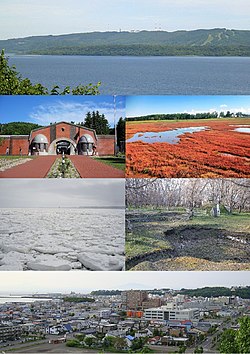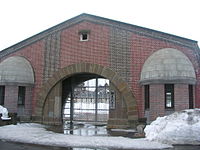Abashiri
Abashiri
網走市 | |
|---|---|
 Top:Panorama view of Mount Tento and Lake Abashiri, Second:Abashiri Prison Museum, View of salicornia europaea in Lake Notoro, Third:View of drift ice in Okhotsk Sea, Ainu Moyoro Midden Ruin Park, Bottom:Panorama view of downtown Abashiri (all item from left to right) | |
 Flag  Emblem | |
 Location of Abashiri in Hokkaido (Okhotsk Subprefecture) | |
 Abashiri Location in Japan | |
| Coordinates: 44°1′N 144°16′E / 44.017°N 144.267°ECoordinates: 44°1′N 144°16′E / 44.017°N 144.267°E | |
| Country | Japan |
| Region | Hokkaido |
| Prefecture | Hokkaido (Okhotsk Subprefecture) |
| Government | |
| • Mayor | Yōichi Mizutani (since December 2010) |
| Area | |
| • Total | 470.94 km2 (181.83 sq mi) |
| Population (February, 2020) | |
| • Total | 34,919 |
| • Density | 85.6/km2 (222/sq mi) |
| Time zone | UTC+09:00 (JST) |
| City hall address | Higashi Yon-chōme, Minami Roku-jō, Abashiri-shi, Hokkaidō 093-8555 |
| Website | www |
| Symbols | |
| Flower | Ezo murasaki-tsutsuji (Rhododendron dauricum) |
| Tree | Katsura |
Abashiri (網走市, Abashiri-shi) is a city located in Okhotsk Subprefecture, Hokkaido, Japan.
Abashiri is known as the site of the Abashiri Prison, a Meiji-era facility used for the incarceration of political prisoners. The old prison has been turned into a museum, but the city's new maximum-security prison is still in use.
As of 2008, the city has an estimated population of 40,333 and a density of 85.6 persons per km2 (222 persons per sq. mi.). The total area is 470.94 km2 (181.83 sq mi).
History[]
The origin of the city's name is not known for certain, but it is agreed that it was derived from an Ainu word. A few among several of the candidates include apa-siri (leakage/ground) and ci-pa-sir ("the land we discovered").[1][2]
- March 1872: Abashiri Village (アバシリ村) founded, being given the name of Abashiri District in Kitami Province.
- 1875: The village name is rewritten in kanji (網走村, same pronunciation).
- 1902: Abashiri Village, Kitami Town, Isani Village, and Nikuribake Village, all in Abashiri District, merged to form Abashiri Town.
- 1915: Notoro Village, Mokoto Village merged.
- 1921: Memanbetsu Village (later Memanbetsu Town, merged into Ōzora in 2006) split.
- 1931: Boundary with Memanbetsu Town modified.
- February 11, 1947: Higashimokoto Village (merged into Ōzora in 2006) split. Abashiri Town becomes Abashiri City. All of the territories of Ōzora used to be a part of Abashiri.
Geography[]
Abashiri is located in the eastern part of Okhotsk Subprefecture, about 50 kilometers east of Kitami. There are no tall mountains, but there are many hills. The Abashiri River flows through the city and there are three lakes (Lake Abashiri, Lake Notoro and Lake Tōfutsu) in the city as well. These lakes and Mount Tento belong to Abashiri Quasi-National Park.
Climate[]
The climate is humid continental with warm summer (Köppen: Dfb) as much of Hokkaido, similar to the south coast of New England.[3] Despite its reputation for extreme cold, Abashiri is not actually the coldest major town in Japan, being less cold in the winter than Obihiro and warmer in summer than Nemuro or Kushiro. Abashiri receives less precipitation than any other city in Japan because its location on the drift ice-affected Sea of Okhotsk,[4] which, however, causes Abashiri to receive less sunshine than the northeast coast since winter snowfall is heavier and fog less confined to the summer months when the Oyashio Current is strongest. During the winter, when Lake Abashiri freezes over, fog becomes a common occurrence.[5] Also, the harbor closes when it ices over.
| hideClimate data for Abashiri, 1981–2010 normals | |||||||||||||
|---|---|---|---|---|---|---|---|---|---|---|---|---|---|
| Month | Jan | Feb | Mar | Apr | May | Jun | Jul | Aug | Sep | Oct | Nov | Dec | Year |
| Record high °C (°F) | 11.8 (53.2) |
11.1 (52.0) |
19.7 (67.5) |
31.9 (89.4) |
35.4 (95.7) |
34.0 (93.2) |
37.0 (98.6) |
37.6 (99.7) |
32.2 (90.0) |
27.7 (81.9) |
21.7 (71.1) |
17.6 (63.7) |
37.6 (99.7) |
| Average high °C (°F) | −2.4 (27.7) |
−2.5 (27.5) |
1.6 (34.9) |
8.9 (48.0) |
14.2 (57.6) |
17.2 (63.0) |
20.8 (69.4) |
23.4 (74.1) |
20.2 (68.4) |
14.8 (58.6) |
7.4 (45.3) |
0.7 (33.3) |
10.4 (50.6) |
| Daily mean °C (°F) | −5.5 (22.1) |
−6 (21) |
−1.9 (28.6) |
4.4 (39.9) |
9.4 (48.9) |
13.1 (55.6) |
17.1 (62.8) |
19.6 (67.3) |
16.3 (61.3) |
10.6 (51.1) |
3.7 (38.7) |
−2.4 (27.7) |
6.5 (43.7) |
| Average low °C (°F) | −9.4 (15.1) |
−10.1 (13.8) |
−5.5 (22.1) |
0.4 (32.7) |
5.4 (41.7) |
9.8 (49.6) |
14.0 (57.2) |
16.6 (61.9) |
12.9 (55.2) |
6.6 (43.9) |
0.1 (32.2) |
−5.9 (21.4) |
2.9 (37.2) |
| Record low °C (°F) | −29.2 (−20.6) |
−25.7 (−14.3) |
−23.2 (−9.8) |
−12.4 (9.7) |
−5.4 (22.3) |
0.1 (32.2) |
2.8 (37.0) |
5.9 (42.6) |
3.3 (37.9) |
−4.6 (23.7) |
−11.3 (11.7) |
−18.0 (−0.4) |
−29.2 (−20.6) |
| Average precipitation mm (inches) | 54.5 (2.15) |
36.0 (1.42) |
43.5 (1.71) |
52.1 (2.05) |
61.6 (2.43) |
53.5 (2.11) |
87.4 (3.44) |
101.0 (3.98) |
108.2 (4.26) |
70.3 (2.77) |
60.0 (2.36) |
59.4 (2.34) |
787.5 (31.02) |
| Average snowfall cm (inches) | 105 (41) |
81 (32) |
66 (26) |
21 (8.3) |
1 (0.4) |
0 (0) |
0 (0) |
0 (0) |
0 (0) |
1 (0.4) |
18 (7.1) |
85 (33) |
378 (148.2) |
| Average snowy days | 27.0 | 24.1 | 22.3 | 11.2 | 2.4 | 0 | 0 | 0 | 0 | 1.4 | 12.5 | 23.4 | 124.3 |
| Average relative humidity (%) | 73 | 74 | 72 | 69 | 73 | 80 | 83 | 81 | 77 | 70 | 68 | 70 | 74 |
| Mean monthly sunshine hours | 114.3 | 139.4 | 172.4 | 177.8 | 189.0 | 174.0 | 168.7 | 172.1 | 165.2 | 160.1 | 121.3 | 115.0 | 1,869.3 |
| Source: Japan Meteorological Agency | |||||||||||||
Economy[]
Because of its short 130-day growing season, the crops in the region, such as oats, potatoes, and beans, are required to be hardy. Hay is also grown for local cows, horses, and sheep.[5] The sea is an important part of the community as well as the economy, as fishing, oysters, and seaweed are important means of livelihood.[5]
Transportation[]
Air[]
Memanbetsu Airport is located in nearby Ōzora.
Rail[]
Abashiri is an important local port city and railway terminal (Abashiri Station).
- JR Hokkaido Sekihoku Main Line: Yobito - Abashiri
- JR Hokkaido Senmō Main Line: Abashiri - Katsuradai - Masuura - Mokoto - Kitahama
Education[]
Universities[]
- Tokyo University of Agriculture, Okhotsk campus
High schools[]
- Hokkaido Abashiri Minamigaoka High School
- Hokkaido Abashiri Keiyo High School
Sister city[]
![]() Port Alberni, British Columbia, Canada - Each year many students participate in student exchange programs between the two cities.[6]
Port Alberni, British Columbia, Canada - Each year many students participate in student exchange programs between the two cities.[6]
Sights[]
Hokkaido has a brewery called Abashiri which sells a range of beers,[7][8] including Bilk, a blend of beer and milk.[9] Abashiri is also home to a flower garden with a wide range of flowers.[5]
In the winter, tourists visit the city to watch the drift ice.

Abashiri Prison
Drift ice off Abashiri
Abashiri's sightseeing ship & icebreaker Aurora II
Museums[]
- Okhost Ryuhyo Museum
References[]
- ^ "市名の由来と紋章". 網走市. Retrieved 2015-11-05.
- ^ "アイヌ語地名リスト ア~イチ P1-10" (PDF). 北海道 環境生活部 アイヌ政策推進室. 2007. Retrieved 2017-10-20.
- ^ "Abashiri Climate Abashiri Temperatures Abashiri Weather Averages". www.abashiri.climatemps.com. Retrieved 2018-12-19.
- ^ http://www.climate-charts.com/Countries/Japan.html[permanent dead link]
- ^ Jump up to: a b c d Kojima, Reikichi (1997). "Abashiri". In Johnston, Bernard (ed.). Collier's Encyclopedia. I A to Ameland (First ed.). New York, NY: P.F. Collier. p. 7.
- ^ Sister city of Abashiri
- ^ "Abashiri Beer - RateBeer". ratebeer.com. 2011. Retrieved 27 October 2011.
- ^ "北海道 網走地ビール の網走ビール株式会社|トップページ". www.takahasi.co.jp. Archived from the original on 2013-03-14. Retrieved 2009-08-25.
- ^ "Milk + Beer = Bilk". Japan Probe. Archived from the original on 2009-07-10. Retrieved 2009-08-25.
External links[]
| Wikimedia Commons has media related to Abashiri, Hokkaido. |
| Wikivoyage has a travel guide for Abashiri. |
- Official Website (in Japanese)
- Abashiri Prison Museum Official Website (in Japanese)
- Abashiri Tourist Information (in English)
- Abashiri, Hokkaido
- Cities in Hokkaido
- Populated coastal places in Japan
- Port settlements in Japan



